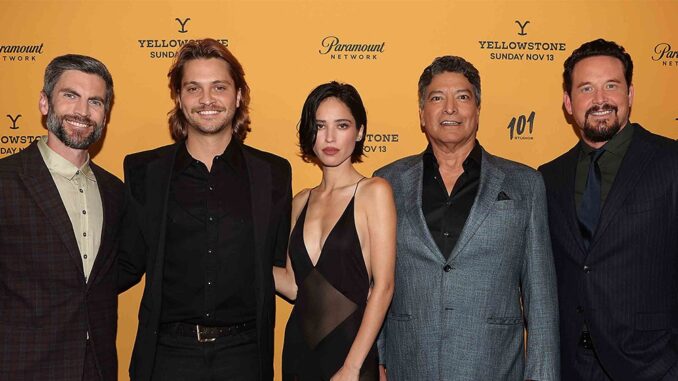
The ‘Yellowstone’ TV Show Is Over, but Not the Damage It’s Done to the West
The sun has set on the beloved TV series ‘Yellowstone’, leaving fans both nostalgic and reflective. While the show’s conclusion marks the end of an era, the ripples it created across the portrayal of the American West continue to linger. Let’s dive deep into how ‘Yellowstone’ has left an indelible mark on the West, both glorifying and distorting its true essence.
The Rise and Reign of ‘Yellowstone’
‘Yellowstone’ swiftly climbed the ranks to become a cultural phenomenon. With its gripping storylines, complex characters, and stunning cinematography, the show captivated audiences worldwide. But beyond its entertainment value, it ignited conversations about the real West and its representation in modern media.
Glamorizing the Western Mythos
One of the most significant impacts of ‘Yellowstone’ is its romanticized portrayal of the Western lifestyle. The vast landscapes, rugged ranchers, and timeless struggles between tradition and progress painted an alluring picture that resonated with many.
The Allure of the Ranch Life
The show’s depiction of ranch life—filled with family ties, honor, and resilience—has inspired countless viewers to romanticize the reality of living on the frontier. However, this portrayal often glosses over the harsh realities and complexities faced by those in the West.
Stereotyping and Simplification
While ‘Yellowstone’ offers a compelling narrative, it also simplifies and stereotypes certain aspects of Western culture. This can lead to misconceptions and a skewed understanding of the region’s diversity.
The Cowboy Archetype

The iconic cowboy figure, central to the series, is both celebrated and critiqued. While embodying strength and independence, this archetype can overshadow the nuanced and varied identities present in the West.
Environmental Narratives and Misrepresentations
‘Yellowstone’ often touches upon environmental issues, showcasing the tension between development and conservation. However, the dramatization can sometimes misrepresent the complexities of these real-world conflicts.
The Battle for Land and Resources
The show highlights fierce battles over land and resources, reflecting real tensions but sometimes exaggerating conflicts for dramatic effect. This can distort public perception of the actual environmental challenges in the West.
H2: Influence on Tourism and Local Economies
The popularity of ‘Yellowstone’ has had tangible effects on tourism and local economies in regions resembling the show’s setting. Fans flock to these areas, seeking to experience the magic portrayed on screen.
H3: The ‘Yellowstone’ Tourism Boom
While increased tourism can boost local economies, it can also lead to overcrowding, environmental strain, and cultural commodification, altering the very essence that made these regions unique.
H2: Impact on Indigenous Communities
The show’s portrayal of Native American characters and their struggles is a double-edged sword. While it brings visibility to indigenous issues, it also risks perpetuating stereotypes and oversimplifying their experiences.
H3: Representation and Responsibility
‘Yellowstone’ has the platform to influence perceptions of indigenous communities. Ensuring accurate and respectful representation is crucial to avoid reinforcing harmful stereotypes.
H2: The Business of Western Narratives
The success of ‘Yellowstone’ has paved the way for more Western-themed content, shaping the future of television and film. This trend underscores the enduring fascination with the American West but also raises questions about originality and authenticity.
H3: Saturation of the Genre
With more shows mimicking the Western genre’s elements, there’s a risk of narrative fatigue and dilution of the genre’s unique storytelling potential.
H2: Cultural Identity and ‘Yellowstone’

The series contributes to the ongoing discourse about American cultural identity, especially concerning the West’s role in shaping national narratives.
H3: Myth vs. Reality
By blurring the lines between myth and reality, ‘Yellowstone’ influences how people perceive the West’s historical and cultural significance.
H2: The Role of Media in Shaping Perceptions
‘Yellowstone’ exemplifies the power of media in shaping societal perceptions, highlighting both its potential and pitfalls.
H3: Narrative Control and Audience Influence
The show’s storytelling choices directly impact how audiences understand and engage with Western themes, demonstrating the media’s role in cultural education and distortion.
H2: The Psychological Impact on Viewers
The intense and dramatic nature of ‘Yellowstone’ can have profound psychological effects on its audience, influencing emotions, beliefs, and behaviors related to the West.
H3: Emotional Engagement and Cognitive Biases
High emotional engagement can lead to cognitive biases, where viewers might adopt the show’s perspectives as their own, affecting their real-world views on Western issues.
H2: Political Undertones and Messaging
‘Yellowstone’ subtly weaves political messages into its narrative, reflecting and potentially shaping viewers’ political opinions about the West.
H3: Power Dynamics and Governance
The show’s depiction of power struggles and governance in the West mirrors real political tensions, offering a dramatized lens through which to view contemporary issues.
H2: The Legacy of ‘Yellowstone’
As ‘Yellowstone’ concludes, its legacy remains a topic of discussion, highlighting both its achievements and the controversies it sparked.
H3: Lasting Cultural Footprint
The series has left a lasting imprint on popular culture, influencing future media portrayals and public discourse about the West.
H2: Lessons Learned and Future Directions
Reflecting on ‘Yellowstone’ provides valuable lessons for creators and audiences alike, guiding future portrayals of the West with greater sensitivity and authenticity.
H3: Striving for Balance and Accuracy
Balancing entertainment with accurate representation is key to creating meaningful and respectful Western narratives that honor the region’s true complexity.
H2: Community Reactions and Feedback
The show has elicited a wide range of responses from communities portrayed and represented, emphasizing the need for ongoing dialogue and understanding.
H3: Voices from the West
Hearing from those who live and breathe the West adds depth to the conversation, ensuring that portrayals like ‘Yellowstone’ are informed and respectful.
H2: The End of ‘Yellowstone’ and What Comes Next
With the show’s conclusion, the landscape of Western-themed media is poised for change, opening doors for new stories and perspectives.
H3: Opportunities for Diverse Storytelling
The void left by ‘Yellowstone’ presents an opportunity for more diverse and authentic storytelling that can better capture the West’s multifaceted nature.
H2: Final Thoughts on ‘Yellowstone’s’ Impact
In wrapping up, ‘Yellowstone’ stands as a testament to the enduring allure of the American West, while also reminding us of the responsibilities that come with its portrayal.
H3: Balancing Fame and Responsibility
As creators and consumers of media, balancing the fame and influence of shows like ‘Yellowstone’ with a commitment to authentic representation is essential for fostering a more accurate and respectful understanding of the West.
Conclusion
‘Yellowstone’ has undeniably left a profound impact on the perception of the American West. While it brought the rugged beauty and complex narratives of the region to a global audience, it also introduced a series of challenges and misconceptions that continue to influence how we view and interact with the West today. As the dust settles, it’s crucial to reflect on both the positive and negative aspects of the show’s legacy, striving for a more nuanced and authentic representation in future media portrayals.
Frequently Asked Questions
1. What made ‘Yellowstone’ so popular among viewers?
‘Yellowstone’ captivated audiences with its intense drama, complex characters, and breathtaking landscapes. The show’s ability to blend traditional Western themes with modern storytelling elements resonated with a wide range of viewers.
2. How did ‘Yellowstone’ influence tourism in the American West?
The show’s popularity led to increased interest in visiting areas that resemble its setting. This surge in tourism brought economic benefits but also posed challenges such as environmental strain and cultural commodification.
3. Were there any criticisms regarding the representation of indigenous communities in ‘Yellowstone’?
Yes, while ‘Yellowstone’ brought visibility to indigenous issues, some critics argue that it perpetuated stereotypes and oversimplified the experiences of Native American communities, highlighting the need for more authentic representation.
4. How did ‘Yellowstone’ impact the Western genre in television and film?
‘Yellowstone’ revitalized interest in the Western genre, inspiring more content with similar themes. However, it also sparked discussions about originality and the importance of diverse storytelling within the genre.
5. What lessons can future creators learn from ‘Yellowstone’s’ portrayal of the West?
Future creators can learn the importance of balancing dramatic storytelling with accurate and respectful representations of the West. Emphasizing authenticity and diversity can lead to more meaningful and impactful narratives.
